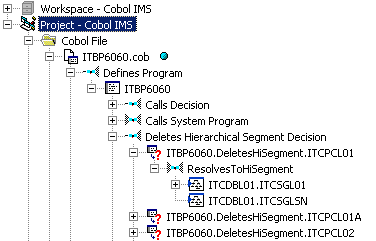IMS Support
Cobol and PL/I applications that use IMS/DB and/or IMS/DC interact with IMS via CBLTDLI calls and PLITDLI calls, respectively. CICS and batch applications may use EXEC DLI commands to interface with IMS. The Enterprise Analyzer IMS Analysis feature examines these call- and command-level interfaces to determine the interactions between programs and the IMS database. It analyzes:
- The DLI-FUNC-CODE parameter to determine the type of operation requested from IMS.
- The PCB-MASK parameter to determine the target segment or target MFS screen for the operation.
IMS Analysis then follows the call chain from the programs performing these calls up to the programs triggered by the operating system, known as root programs. Since the root programs have a PSB associated with them, the analysis can establish which PCB is used in the call to IMS. With this information, Enterprise Analyzer can create repository relationships that reflect the interactions between programs and the IMS database. Before IMS analysis, in other words, you will see only calls to CBLTDLI, PLITDLI, or EXEC DLI. After IMS analysis, you will see CRUD information and MFS screen interactions.
Follow the steps below to perform IMS Analysis:
- In addition to the basic source files for the Cobol or PL/I application, register the source files that describe the IMS environment
for the application. Enterprise Analyzer supports the following IMS-related file types:
- DBD files (.dbd). These files contain definitions for IMS segments and are the input to the macro DBDGEN in IMS.
- MFS files (.mfs). These files contain the screen definitions for an IMS system and are the input for MFSGEN.
- MFS Include files (.mfi).
- PSB files (.psb). These files contain the list of PCBs accessible by the program and are the input for PSBGEN.
- PSB Copybook File (.psbcpy).
- System Definition Files (.ims).
- Ensure verification options are set correctly:
- For Cobol files, ensure the default Perform Program Analysis and Enable Data Element Flow options are set in Project Options > Verification > Advanced Program Analysis.
- For PL/I files, ensure the default Enable Data Element Flow option is set in Project Options > Verification > Advanced Program Analysis.
- Verify application source files. You can:
- Verify the entire project, which ensures that files are parsed in the appropriate order, taking account of the dependencies between file types.
- Verify files or file types individually, in which case you should follow the order specified in "Verification Order for IMS Applications."
- When all source files have been verified successfully, choose Prepare > IMS Analysis. Enterprise Analyzer analyzes the calls to IMS to determine the type of IMS operation performed (Insert, Read, Change, Delete) and the target segment or target MFS screen for the operation.
The figure below shows typical results of IMS Analysis. The objects marked with the
![]() icon are abstract decision objects, indicating that the database operation, in this case, Deletes, has been resolved to multiple
segments.
icon are abstract decision objects, indicating that the database operation, in this case, Deletes, has been resolved to multiple
segments.
